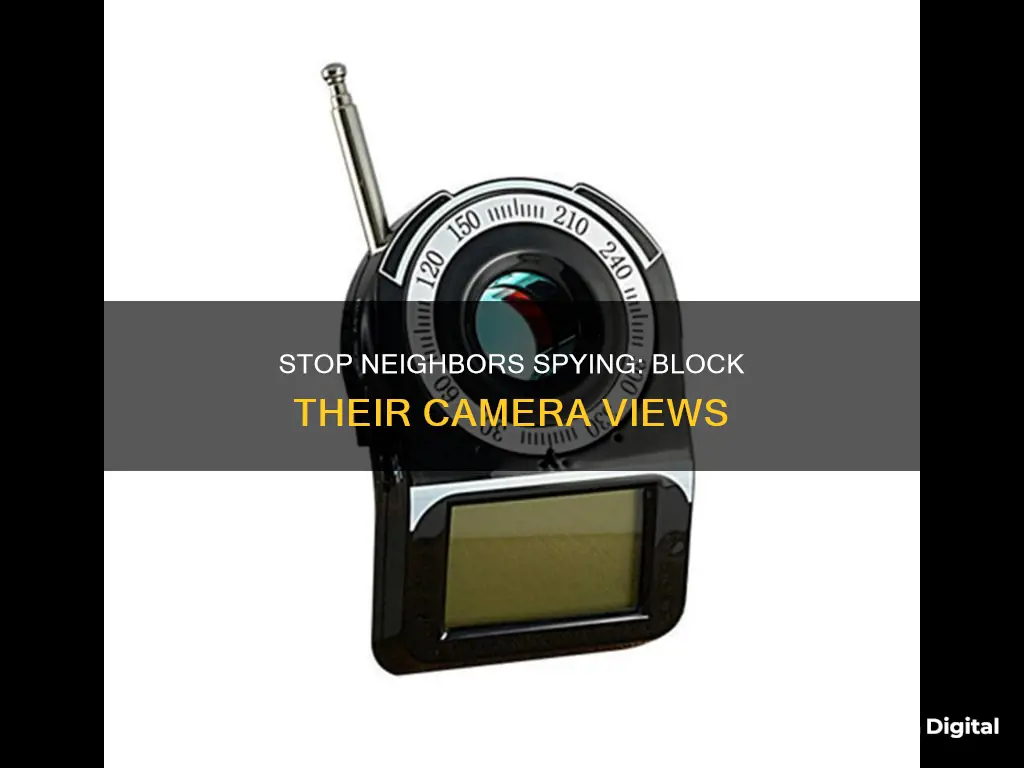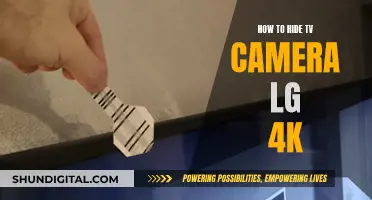
Security cameras are a great way to protect your home from intruders, but they can also be a source of tension between neighbours if they are pointed at each other's properties. If you feel that your neighbour's security camera is invading your privacy, there are a few things you can do to address the situation.
First, it's important to determine whether the camera is real or fake. Many people buy realistic-looking dummy cameras to deter thieves, so it's worth checking if the camera is actually functioning before taking any action.
If the camera is real, the next step is to talk to your neighbour. Open and polite communication is the best way to resolve the issue. Express your concerns and ask them to adjust the angle or change the direction of the camera. They may not realise that the camera is pointing at your property, and a friendly conversation can often resolve the problem.
If talking to your neighbour doesn't work, you can seek help from mediators in your local community or neighbourhood mediation centres. These professionals are experienced in handling neighbourhood disputes and can help facilitate a resolution.
Another option is to block the camera's view by planting trees or shrubs, installing privacy fences or screens, or using reflective materials to bounce light and create lens flares. You can also install your own security camera to send a message to your neighbour, but be mindful of local laws and regulations regarding camera placement.
Finally, if all else fails and you believe your neighbour is recording your property illegally, you can consult a lawyer or the police for advice. Remember, it is important to respect your neighbour's right to protect their property while also asserting your right to privacy.
| Characteristics | Values |
|---|---|
| Communicate with your neighbour | Politely ask them to adjust the angle or change the direction of the camera |
| Check if the camera is real | Observe if the camera has a red light flashing at night or ask your neighbour directly |
| Check if the camera has blind spots | Pay attention to the daily movement of the camera and check if it has PTZ functions |
| Seek help from a third party or mediators | Contact your local community service or neighbourhood mediation centres |
| Block the camera's view | Use tall shrubs, grown trees, fences, curtains, privacy screens, or natural barriers such as tall hedges or trellises with climbing plants |
| Install your own security camera | Mount a Pan-Tilt-Zoom (PTZ) security camera to make your neighbours doubt their actions |
| Consult a lawyer or the police | If your neighbour deliberately points the camera at your private spaces, report them to the authorities |
What You'll Learn

Communicate with your neighbour
Communicating with your neighbour is the first step in solving this problem. It is recommended to approach the situation with politeness and openness. Express your concerns and confusion about the cameras, and politely ask them to adjust the angle or change the direction of the camera. There is a chance they are unaware of the camera's positioning, and they may be willing to help.
Before you speak to your neighbour, it is a good idea to research the laws and regulations in your area regarding security cameras and privacy. Understanding these laws can help guide your conversation and any further actions. For example, in many places, there are specific rules about where cameras can be pointed and what can be recorded.
If your neighbour is pointing their camera at areas where you have a reasonable expectation of privacy, such as your bedroom or bathroom, they may be invading your privacy. In this case, you can inform them of the relevant laws and ask them to adjust their camera accordingly.
If your initial conversation does not go as planned, you can seek help from mediators in your local community or neighbourhood mediation centres. These people are experienced in dealing with neighbourhood disputes and can help mediate a meeting between you and your neighbour to resolve the issue.
Remember, it is important to remain calm and respectful throughout the process, even if your neighbour is unreasonable. Physical damage to their camera or any other property is not recommended and can lead to legal trouble.
Publix's Camera Surveillance: What Shoppers Should Know
You may want to see also

Install privacy fences or screens
One of the most effective ways to block a neighbour's security camera is to install a privacy fence or screen. This method is a more permanent solution, providing a physical barrier between the camera and your property. There are a variety of options available on the market that can enhance privacy and block unwanted surveillance.
When choosing a privacy fence or screen, consider the height, material, and design to ensure it effectively blocks the camera's view. Opt for fences or screens that are tall enough to cover the areas within the camera's field of vision. For example, if the camera is pointed towards your windows or private spaces, ensure the fence or screen is tall enough to obscure those areas.
Privacy fences are typically made from wood, vinyl, or metal and can be solid or have slats. Solid fences provide complete privacy, while slatted fences allow for some visibility and air circulation. Metal fences, such as wrought iron or aluminium, offer durability and security but may have wider gaps between bars that a camera could see through. Vinyl fences are low-maintenance and long-lasting, providing privacy without sacrificing style.
Privacy screens are another option, offering flexibility and ease of installation. They can be made from a variety of materials, including wood, bamboo, composite, or metal, and can be freestanding or attached to an existing structure. Screens can be placed strategically to block specific views, providing targeted coverage. Some privacy screens are designed with decorative patterns or natural elements, adding aesthetic appeal to your space while enhancing privacy.
Before installing a privacy fence or screen, be sure to check local regulations and guidelines regarding fencing and privacy structures. It is important to understand any height restrictions or permit requirements to ensure your installation complies with local laws. Additionally, consider the impact on your relationship with your neighbour. While it is your right to enhance your privacy, open communication and mutual understanding can help foster a more harmonious environment.
Apple Watch: Camera Feature or Missing Component?
You may want to see also

Use natural barriers
Natural barriers are an excellent way to block your neighbour's security camera without causing offence or breaking any laws. Here are some ways to use natural barriers to protect your privacy:
Plant Trees and Shrubs
A natural and aesthetically pleasing way to block your neighbour's line of sight is to plant tall trees or dense shrubs along the boundary between your properties. Choose plants that provide year-round coverage and grow to an appropriate height. For a more manicured look, consider a sheared privet hedge, or for a natural privacy screen, opt for fast-growing columnar evergreens such as Italian cypress or arborvitae, which are perfect for narrow spaces. If you have a larger yard, you can create a layered planting scheme that combines deciduous and evergreen trees, shrubs, and perennials to add depth and visual interest.
Install Privacy Fences or Screens
If you need a more immediate solution, installing a privacy fence or screen along the property line can physically block the camera's view. Ensure that any structures comply with local regulations and do not infringe on your neighbour's property rights. You can also add an open lattice or baluster top to a solid fence to improve airflow and create a more aesthetically pleasing solution.
Use Tall Hedges or Trellises
If planting trees or installing fences is not feasible, consider other natural barriers such as tall hedges or trellises with climbing plants. These can create effective visual barriers without blocking airflow or sunlight. For a more permanent structure, you could also build a stone wall topped with fencing or a masonry wall with ornamental ironwork. These options provide privacy while maintaining an open feel and allowing for controlled views and airflow.
Use Container Gardens for Deck Privacy
For a flexible and movable solution, container gardens can be strategically placed on decks and patios to form a green screen around seating areas. Choose lightweight containers with casters so you can easily rearrange them as needed. For a long-lasting display, combine showy annuals with ornamental grasses or shrubs that change colour in the fall.
To enhance the effectiveness of natural barriers, you can combine them with man-made structures. For example, you could plant flowering or evergreen shrubs in front of a privacy fence to soften its appearance, or incorporate climbing plants to add texture and colour to the surface of a fence or wall.
Apple Watch Ultra: Camera Expectations and Realities
You may want to see also

Install your own security camera
Installing your own security camera can be an effective way to deter your neighbours from watching you with their cameras. Here is a comprehensive guide on how to install a security camera:
Planning
Before purchasing any equipment, decide where you want to install the cameras. Identify the priority areas you want to monitor and consider possible camera angles. Typical security camera placements include entry doors, off-street windows, porches, stairways, driveways, and interior common rooms. It is recommended to place cameras in corners to achieve the widest possible field of view.
Purchasing
When purchasing a home security camera, you can choose between a wired or wireless setup. Wired security cameras are a good choice if you have a large property to cover, but the installation process will be more complex and require more steps. Wireless security cameras, on the other hand, require minimal drilling, but powering them can be tricky, especially if you want to cover a large area.
Installation
Most security camera systems come with detailed instructions to help you with the installation process. If you plan to use a wired system, map out the location of the components and figure out how you will run the wires to connect the camera to the DVR box. Running cables for a wired system will involve drilling holes into walls and ceilings, so you may want to consider hiring a professional installer if you are not comfortable with this.
Mounting
To mount a wireless security camera, find a solid surface for the mount and use the provided screws to attach it. Most camera kits come with a drill template to help you place the screws correctly. Drill pilot holes where indicated for the mounting screws and lightly tap in any included mounting pins. Finally, screw the camera mount securely into the wall and adjust the camera to the desired angle.
For wired security cameras, you will need to attach the camera mounts and run the cables to the DVR box. Drill pilot holes for the mounting screws and a larger hole in the centre for the cables to exit. Run the security camera cables through the camera mount point and behind the wall until you reach the point where the DVR box will be mounted. Use fish tape to help feed the cables through tight spots. Attach the camera to the power source if needed, and then secure the camera onto the mount.
Network Connection
Connect the input cable of your wired camera to the DVR box and write down which input port each camera is connected to. Connect the DVR output port to the input slot of a monitor. Ensure that all components are connected to a power source and that all cables are securely connected. If you have a wireless system, you will only need to install the software that came with the device and follow the instructions to complete the setup.
Storage Setup
Set up a storage system for your camera's footage. You can use a cloud account, connect the camera to a local storage device such as a DVR, computer, or NVR, or insert an SD or mini SD card into the memory slot on the camera.
Customise Settings
Open the camera app and play around with the features of the surveillance system. Common options to customise include motion sensitivity and brightness. You can also set up two-factor authentication to provide an extra layer of security for your camera system.
Do Principles Spy on Teachers via Cameras?
You may want to see also

Seek legal help
If you feel that your neighbour's security cameras are invading your privacy, you may be able to take legal action. However, the law on this issue is complex and varies depending on where you live.
Invasion of Privacy
In the US, there is no federal law guaranteeing privacy, but the Supreme Court has used the personal protections guaranteed by the First, Third, Fourth, Fifth, and Ninth Amendments to find an implied right to privacy.
State laws vary, but in general, you have a legal right to privacy in your home. This means that your neighbour cannot legally record you in your home without your consent. However, if the camera is pointed at a public area outside your home, such as your front yard, you cannot press charges.
What to Do
Before taking legal action, it is a good idea to try to resolve the issue with your neighbour. Write them a note or knock on their door and politely ask them to adjust the angle of the camera.
If this does not work, you could try blocking the camera's view by planting trees or shrubs, or installing a fence.
If you still cannot resolve the issue, you could consult an attorney or contact the police, especially if your neighbour is deliberately pointing the camera at your bedroom or private areas.
Paranormal Caught on Camera: Best Viewing Platforms
You may want to see also
Frequently asked questions
Your neighbour is legally allowed to have security cameras installed on their property, even if they are aimed at your property. However, they do not have the right to record you or anyone else without consent in areas with a reasonable expectation of privacy, such as your bedroom or bathroom.
The first step is to talk to your neighbour and politely ask them to adjust the angle or change the direction of the camera.
You can seek help from a third party or mediator, such as your local community service or neighbourhood mediation centre. They can help organise a mediated meeting between you and your neighbour to resolve the issue.
Yes, you can plant tall trees or dense shrubs along the boundary between your properties, install privacy fences or screens, or use reflective materials that bounce sunlight or artificial light towards the camera to cause lens flares.
Yes, you can legally install security cameras on your property to protect your privacy.







